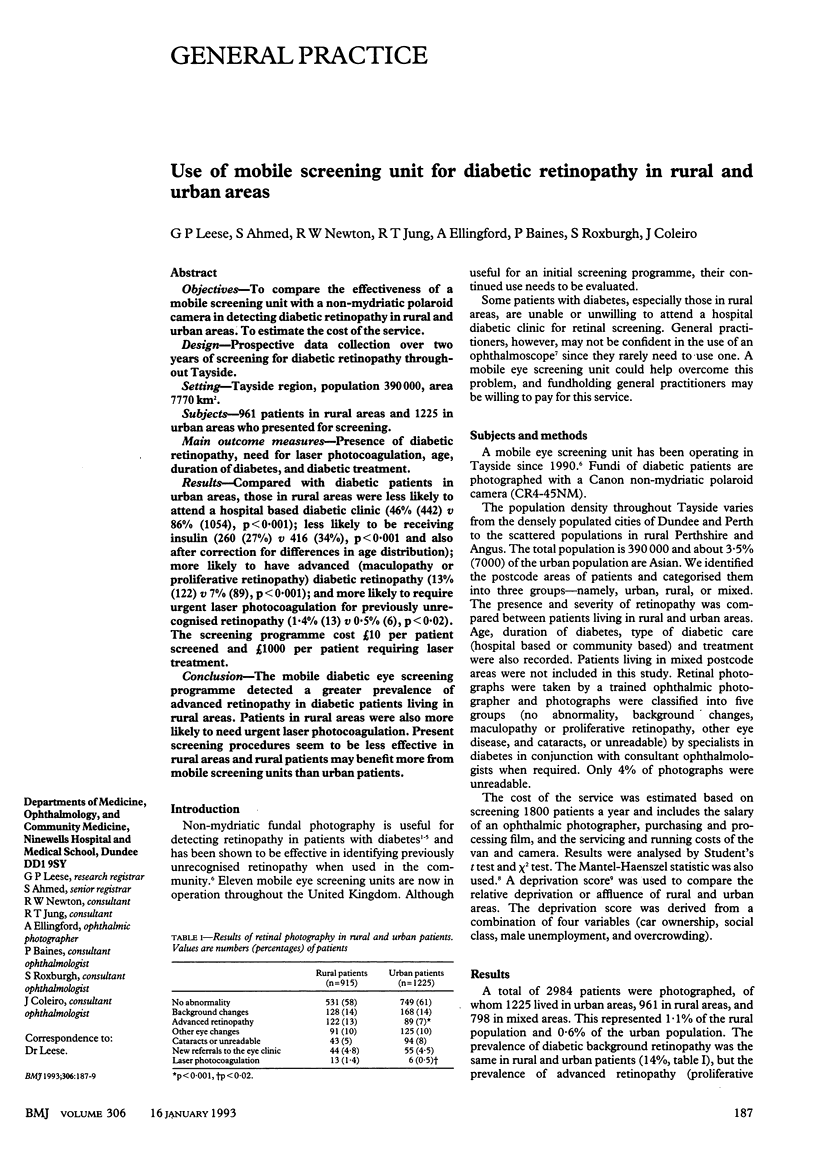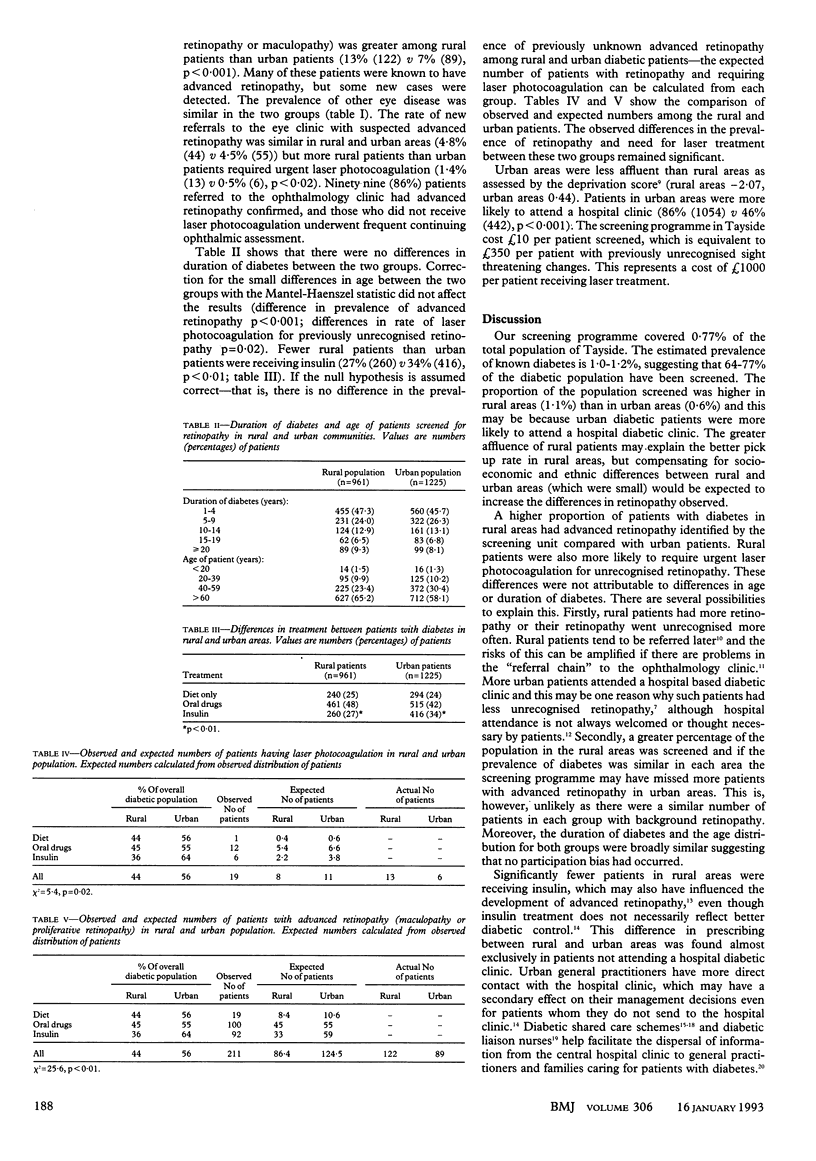Abstract
OBJECTIVES--To compare the effectiveness of a mobile screening unit with a non-mydriatic polaroid camera in detecting diabetic retinopathy in rural and urban areas. To estimate the cost of the service. DESIGN--Prospective data collection over two years of screening for diabetic retinopathy throughout Tayside. SETTING--Tayside region, population 390,000, area 7770 km2. SUBJECTS--961 patients in rural areas and 1225 in urban areas who presented for screening. MAIN OUTCOME MEASURES--Presence of diabetic retinopathy, need for laser photocoagulation, age, duration of diabetes, and diabetic treatment. RESULTS--Compared with diabetic patients in urban areas, those in rural areas were less likely to attend a hospital based diabetic clinic (46% (442) v 86% (1054), p < 0.001); less likely to be receiving insulin (260 (27%) v 416 (34%), p < 0.001 and also after correction for differences in age distribution); more likely to have advanced (maculopathy or proliferative retinopathy) diabetic retinopathy (13% (122) v 7% (89), p < 0.001); and more likely to require urgent laser photocoagulation for previously unrecognised retinopathy (1.4% (13) v 0.5% (6), p < 0.02). The screening programme cost 10 pounds per patient screened and 1000 pounds per patient requiring laser treatment. CONCLUSION--The mobile diabetic eye screening programme detected a greater prevalence of advanced retinopathy in diabetic patients living in rural areas. Patients in rural areas were also more likely to need urgent laser photocoagulation. Present screening procedures seem to be less effective in rural areas and rural patients may benefit more from mobile screening units than urban patients.
Full text
PDF


Selected References
These references are in PubMed. This may not be the complete list of references from this article.
- Dornan C., Fowler G., Mann J. I., Markus A., Thorogood M. A community study of diabetes in Oxfordshire. J R Coll Gen Pract. 1983 Mar;33(248):151–155. [PMC free article] [PubMed] [Google Scholar]
- Editorial: What about the real problems? Br Med J. 1976 Jan 3;1(6000):1–1. [PMC free article] [PubMed] [Google Scholar]
- Hayes T. M., Harries J. Randomised controlled trial of routine hospital clinic care versus routine general practice care for type II diabetics. Br Med J (Clin Res Ed) 1984 Sep 22;289(6447):728–730. doi: 10.1136/bmj.289.6447.728. [DOI] [PMC free article] [PubMed] [Google Scholar]
- Higgs E. R., Harney B. A., Kelleher A., Reckless J. P. Detection of diabetic retinopathy in the community using a non-mydriatic camera. Diabet Med. 1991 Jul;8(6):551–555. doi: 10.1111/j.1464-5491.1991.tb01650.x. [DOI] [PubMed] [Google Scholar]
- Jones R. B., Larizgoitia I., Casado L., Barrie T. How effective is the referral chain for diabetic retinopathy? Diabet Med. 1989 Apr;6(3):262–266. doi: 10.1111/j.1464-5491.1989.tb01158.x. [DOI] [PubMed] [Google Scholar]
- Leese G. P., Newton R. W., Jung R. T., Haining W., Ellingford A. Screening for diabetic retinopathy in a widely spaced population using non-mydriatic fundus photography in a mobile unit. Tayside Mobile Eye Screening Unit. Diabet Med. 1992 Jun;9(5):459–462. doi: 10.1111/j.1464-5491.1992.tb01817.x. [DOI] [PubMed] [Google Scholar]
- Nathan D. M., Fogel H. A., Godine J. E., Lou P. L., D'Amico D. J., Regan C. D., Topping T. M. Role of diabetologist in evaluating diabetic retinopathy. Diabetes Care. 1991 Jan;14(1):26–33. doi: 10.2337/diacare.14.1.26. [DOI] [PubMed] [Google Scholar]
- Rogers D., Bitner-Glindzicz M., Harris C., Yudkin J. S. Non-mydriatic retinal photography as a screening service for general practitioners. Diabet Med. 1990 Feb;7(2):165–167. doi: 10.1111/j.1464-5491.1990.tb01353.x. [DOI] [PubMed] [Google Scholar]
- Sculpher M. J., Buxton M. J., Ferguson B. A., Humphreys J. E., Altman J. F., Spiegelhalter D. J., Kirby A. J., Jacob J. S., Bacon H., Dudbridge S. B. A relative cost-effectiveness analysis of different methods of screening for diabetic retinopathy. Diabet Med. 1991 Aug-Sep;8(7):644–650. doi: 10.1111/j.1464-5491.1991.tb01671.x. [DOI] [PubMed] [Google Scholar]
- Tattersall R. The future role of the diabetes specialist nurse--responsibility without authority? Diabet Med. 1986 Mar;3(2):166–167. doi: 10.1111/j.1464-5491.1986.tb00731.x. [DOI] [PubMed] [Google Scholar]
- Taylor R., Lovelock L., Tunbridge W. M., Alberti K. G., Brackenridge R. G., Stephenson P., Young E. Comparison of non-mydriatic retinal photography with ophthalmoscopy in 2159 patients: mobile retinal camera study. BMJ. 1990 Dec 1;301(6763):1243–1247. doi: 10.1136/bmj.301.6763.1243. [DOI] [PMC free article] [PubMed] [Google Scholar]
- Williams R., Nussey S., Humphry R., Thompson G. Assessment of non-mydriatic fundus photography in detection of diabetic retinopathy. Br Med J (Clin Res Ed) 1986 Nov 1;293(6555):1140–1142. doi: 10.1136/bmj.293.6555.1140. [DOI] [PMC free article] [PubMed] [Google Scholar]
- Yudkin J. S., Boucher B. J., Schopflin K. E., Harris B. T., Claff H. R., Whyte N. J., Taylor B., Mellins D. H., Wootliff A. B., Safir J. G. The quality of diabetic care in a London health district. J Epidemiol Community Health. 1980 Dec;34(4):277–280. doi: 10.1136/jech.34.4.277. [DOI] [PMC free article] [PubMed] [Google Scholar]


